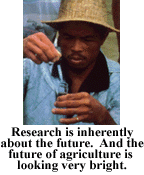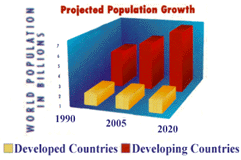 |
Research Magazine > ARCHIVE > Winter
97 > Article
VIEWPOINT
The Global Face of Agriculture

With a new millennium just a little more than a thousand days away, it's
popular for people to talk about the dawning of a new era - an age of international
cooperation and shared research.
But there's nothing new about that era - at least, not in the UGA College of
Agricultural and Environmental Sciences. In agriculture, the era of international
research dawned ages ago.
As American as apple pie? The apple is an import. So is rice. The potato. Peppers.
In fact, so are most of our fruits, vegetables and grains. Like most Americans,
most American crops are immigrants, the product of research with plants brought
from other shores.
Georgia has an especially ripe history of international agriculture research.
More than a quarter of a millennium ago, in 1732, General James Oglethorpe
began America's first agricultural experiment garden in Savannah. This forerunner
of modern agricultural experiment stations had a special mission to investigate
international plant varieties. Its research led to the cultivation of crops
that fueled the colony's economy for generations.
That international research tradition has continued throughout our history,
as have the benefits of its successes. A half-century ago, when Dr. Glenn Burton
began collecting African Bermuda grasses for research at the Coastal Plain
Experiment Station in Tifton, he was planting the seeds in Georgia for the
world's first turfgrass industry that today covers lawns, golf courses and
athletic fields worldwide.
But international research is not merely a part of Georgia's past. Research
is inherently about the future. And if you look at the future of agriculture,
you'll see how bright we really can make it.
The College of Agricultural and Environmental Sciences has the largest international
research program at the university, with total federal funding of nearly $5
million a year. We have formal agreements with 27 colleges and universities
worldwide. Of our 260 teaching and research faculty, 106 participate in international
work of some kind. Their work takes many forms, but it almost always results
in dividends to the scientists, to the university, to Georgia's farmers and
to the state's consumers.
Sometimes those benefits are economic; sometimes they come in the form of new
knowledge. Usually they encompass both.
We no longer live in a world where we can take for granted America's preeminence
in technology, education and manufacturing. One trip to the grocer's produce
section provides convincing evidence that many countries have a great deal
to offer us. Access to fundamentals such as seed and germplasm for our important
food and fiber crops, as well as emerging technologies produced in other countries,
are crucial to protecting our quality of life here in America.
To fully understand this, envision how the world will look around the year
2020:
- The world's population will
rise from 5.7 billion to more than 8 billion people.
- Ninety percent of
this growth will take place in developing nations, which means nine out
of every 10
people will live in a developing country.
- Six of the top 10 economies
will be in Southeast Asia and will represent 60 percent of the
world's food buyers.
These countries are becoming more affluent. Their
people will no longer
eat three bowls of rice a day. They are going to want chicken,
beef and other products
in their diet. As developing nations' food consumption changes from
cereal-based to protein-based diets, demands for U.S. food products
- such as Georgia's
largest export product, poultry - will grow.
Georgia is already an active player in the agricultural export market
with more than $760 million of agricultural products exported
annually. In the future,
it will be critical for us to continue to be competitive - and to
find ways to increase our competitiveness - in the international
marketplace.
International agriculture programs significantly promote U.S.
agricultural exports. In fact, of the 50 largest customers of
U.S. farm goods, 43 are
countries that formerly received food aid from the United States.
The International Food Policy Research Institute in Washington,
D.C., reports that each dollar invested in agricultural research
in developing
countries
generates $4.39 of additional imports by these countries C $1.06
of that return is in agricultural imports. All of these are compelling
reasons
to remain on
the cutting edge of international agriculture research.
But in addition to the economic advantage we gain through international
programs, we have much to gain in technology, genetic resources
and ideas. Recently,
Australian researchers came to the aid of Georgia farmers when a
disease called "blackleg" threatened
our state's small but growing number of canola producers.
Australia's willingness to share blackleg-resistant canola varieties
restored growers' confidence and helped prevent a major setback
to this fledgling industry.
Likewise, research with grasses in Africa and South America revolutionized
the beef cattle industry in the American Southeast by providing tough,
heat- and drought-tolerant, year-round forage and hay for growing
cattle. This
research ultimately led to the development of the world's first
turfgrasses and an entirely
new U.S. industry.
Clearly, the College of Agricultural and Environmental Sciences'
participation in international activities is vital. We must encourage
more faculty and
students to take advantage of opportunities to study, teach and
conduct research abroad
if Georgia is to flourish in the coming era.
Our role in the Office of International Agriculture is to educate
our future farmers, business representatives, researchers and teachers
so they can lead
us in the 21st century. Our graduates must have an international
perspective
on policy, demographics, trade, economics and environmental issues;
they must be able to speak a second, or even a third, language; they
must
have experienced
another culture by studying or living abroad.
This is a tall order, but necessary. Our graduates will be positioned
to use these educational tools to secure not only Georgia's successful
participation
in the international marketplace, but also the United States' leadership
role in encouraging economic, agricultural and environmental
sustainability around
the world.
In the College of Agricultural and Environmental Sciences, we are
committed to building on our international research tradition.
If past is truly prologue, then Georgia faces a truly spectacular
future in agriculture.
For more information, access http://www.uga.edu/caes/.
UGA Regents Professor Edward T. Kanemasu directs the
international agriculture office and has an active research program in the
use of remote sensing and geographical information systems in agricultural
meteorology.
Kanemasu is also the administrative coordinator for the Peanut and the SANREM
(Sustainable Agriculture and Natural Resource Management) Collaborative Research
Support Programs. These international research programs are funded by the U.S.
Agency for International Development at approximately $2 million per year.
Return to Winter 1997 Index
Research
Communications, Office of the VP for Research, UGA
For comments or for information please e-mail the editor: rcomm@uga.edu
To contact the webmaster please email: ovprweb@uga.edu
|
| |

|
|



|
|


